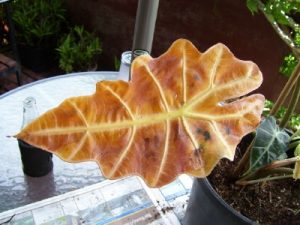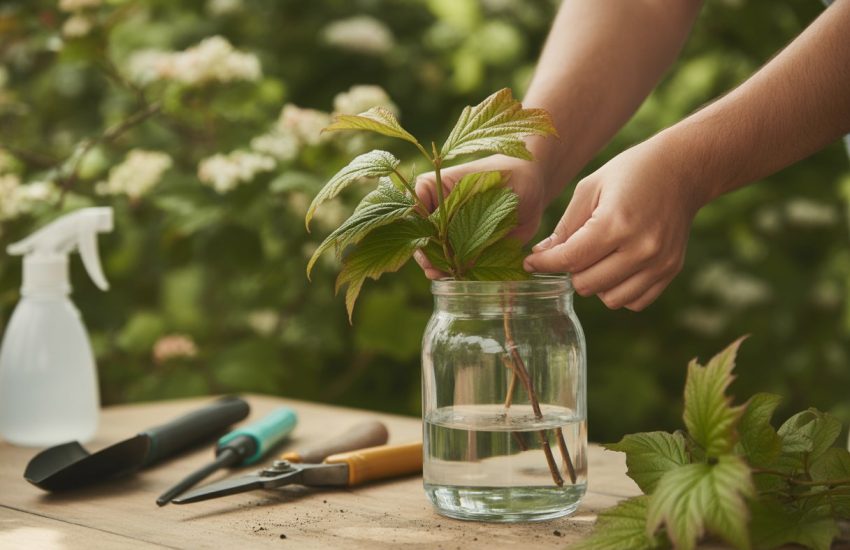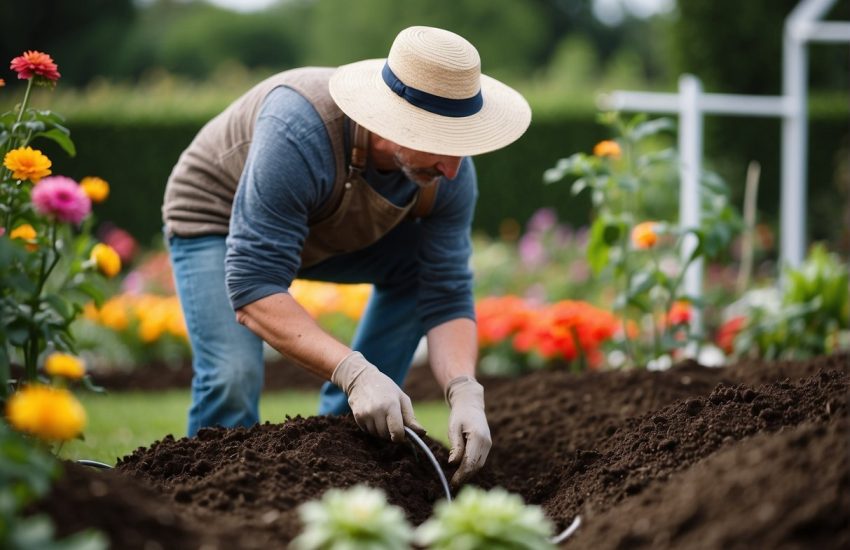Causes And Solutions Of Alocasia Leaves Turning Yellow
Alocasias come from Asia’s and eastern Australia’s tropical forests. The plant generally thrives in bright and hot conditions. The Alocasia plants are magnificent but can sometimes be temperamental. Their leaves can still turn yellow despite your best efforts. Below are the causes of Alocasia leaves turning yellow and their solutions.
Causes And Solutions Of The Alocasia Leaves Turning Yellow

- Normal Aging
When finding reasons behind the leaves of your Alocasia plant turning yellow, always remember to factor in age. As the Alocasia leaves grow old, they turn yellow and then die. This is a natural process. The leaves’ growing old is part of a stage in the life cycle of their foliage. They may turn yellow due to growing old and being shut down and drained of all the resources. The shutdown of leaves mostly happens to outer and older leaves. Thus, even with adequate water and light, the leaves may still turn yellow if they are old. This happens so that it can provide room for a new leaf to start growing. However, there are no solutions to treating normal ageing.
- Overwatering
This is the most common cause for the Alocasia leaves to turn yellow. The plant prefers to be in a damp area rather than wet. If you overwater the plant, its roots will be too wet and start to rot. This will cause the death of the Alocasia. If your Alocasia leaves are turning yellow, start by checking the plant’s roots and soil. Alocasia roots are supposed to be firm, stiff, and with an earthy smell. If its roots have a foul smell, are squishy, and rotted, it will indicate that the cause of the leaves turning yellow is overwatering.
Solution To Overwatering
- Inspect the roots of the plant.
- Trim the yellow leaves from the plant and transfer them to drier soil.
- For the rot roots, use a fungicide to treat them, and you should apply it with a spray bottle.
- You should also wait about a week before watering the plant again.
- Examine your plant for at least two days to see if it is picking up.
Tips To Water Your Alocasia Plant The Right Way
- Before you water it, allow about three inches of the soil to dry out.
- You should water evenly so that all areas of the soil are soaked.
- Review your soil timely by gently uprooting the plant or putting your finger in the soil to check if you are watering the plant appropriately or not.
- Fill the pot with water but not fully, and drain any accumulated water from the Alocasia pot through its drainage hole.
- Low Humidity Levels
Alocasia plants thrive in humid conditions. They may grow in lower humidity levels, but they should be at 60% to flourish. When Alocasia is exposed to low humidity levels, its leaves will turn yellow with brown margins. This will result in all the leaves on the plant getting yellow.
Solutions To Low Humidity Levels
- Use a humidifier if your plant is not growing in a tropical region.
- Mist your plant to increase the humidity levels.
- When there are average humidity levels, group your Alocasia plant with tropical plants and place them close by a few water-filled trays.
- Another option is to place your plant in a bath and give it a rinse.
- Using Unfiltered Water Or Tap Water
Unfiltered water has several harmful heavy metals that will not help your plant grow. Tap water has calcium and magnesium, which may build up on the surface of the soil and cause a white powdery layer. As a result of the excess salts, the roots can be dehydrated. Alocasia plant reacts negatively with contaminated water or heavily mineralized water. Therefore, its leaves will start turning yellow, and will have brown tips and edges.
Solution To Using Unfiltered Water
- You can neutralize tap water chemically by adding a few drops of de-chlorinator before watering your Alocasias.
- You can also switch to rainwater or purified water to avoid the discoloring of the leaves.
- The Wrong Potting Mix
Completely dry or damp soil is unfavorable for an Alocasia plant. Instead of wholly drenched soil, the Alocasia plant prefers a moist one. Suppose the soil lacks nutrients and attributes like the capacity to drain excess water and store moisture. The plant thrives in crumbly and loamy soil with a slightly acidic pH, between 5.5 and 6.5. wet soil will rot the plant’s roots, and its leaves will turn yellow.
Solution To Mixing An Ideal Pot
Mix peat in the plant’s soil to increase the soil’s capacity to hold water. You should be keen not to add it to the soil of a species that needs drier soil as it will hold plenty of moisture.
An ideal soil-based potting mix should have:- 5 lbs. ground limestone
- 10 lbs. bone meal
- 5 lbs. blood meal
- A half cubic yard of clean builder’s perlite or sand
- A half cubic yard mature compost or coconut coir or peat moss
- Inadequate Sunlight
The Alocasia leaves may also turn yellow as a result of insufficient lighting. The plant is considered a low-light plant because it is commonly found in tropical shades. After all, there are favorable humid conditions there.
When there is seasonal change, in which sunlight rays are less intense, the Alocasia plant can have its leaves turn pale and yellow. The leaves of an Alocasia plant mainly turn yellow because of inadequate light, but they can also turn yellow because of exposure to excessive sunlight.
Solutions To Inadequate Sunlight
- Plant your Alocasias near a window facing south, so they are not light blocked.
- If the Alocasia leaves have turned yellow and are also scorched, you should consider shifting the plant to a better position where it will receive adequate light, but the sunlight should be indirect.
- The Alocasia plant prefers to withstand exposure to indirect sunlight for a whole day.
- Protect the plant from too much sunlight by using plenty of mulch. Mulch will reflect sunlight and assures the plant of moderate conditions.
- Temperature Extremities
The Alocasia plant thrives in warm and humid climates. Thus, it will grow well in an area above 18 degrees Celsius. It can flourish up to temperatures of 29 degrees Celsius. The Alocasia plant is not frost-resilient and will suffer if the temperatures drop below 13 degrees Celsius. Your Alocasia may have turned yellow if it is being grown in extreme temperatures. Planting your plant indoors with high or low temperatures will prevent it from absorbing the heat it needs to thrive.
Solution To Temperature Extremities
- To keep your plant roots warmer, use equipment like heating pads.
- Also, you can bubble wrap your Alocasia plant.
- Mist the plant’s leaves to ensure it has in a more humid condition.
- Do not place your plant in front of an air conditioner or heater.
- Insufficient Fertilizer
While the Alocasia plant having insufficient fertilizer is a rare cause for the leaves to turn yellow, it is still possible. Insufficient fertilizer corresponds to a lack of sufficient nutrition. Therefore, nutritional deficiency can cause the Alocasia leaves to pale and yellow. Your Alocasia plant can also gain nutritional value from natural sunlight in the warm seasons.
Solution To Insufficient Fertilizer
Find treatment for the plant depending on the nutritional deficiency it has. They include:
- The symptom of having yellowing in the veins of the leaves means that it lacks magnesium and sulfur. You can treat this by using Epsom salt before watering and manganese sulfate.
- The symptom of the mature and older leaf blades having uniform yellowing in their veins means it has a nitrogen deficiency. You can treat it by using fertilizing rich in water-soluble nitrogen while watering.
- You should also be keen not to over-fertilize as it will cause the plant’s leaves to burn or turn yellow. For overfertilizing, you can immediately stop fertilizing the plant. Rinse the plant’s pot with clean water to wash off the excess fertilizer.
- Pests And Diseases Infestation
The Alocasias are prone to houseplant pests like aphids and spider mites. The pests infect the plant because of its big, juicy, soft leaves. If infested with bugs, the leaves will turn yellow. The bugs attack the plant to feed on the nutrients in the leaves. To know if your Alocasia plant is infested with pests, you can identify if your plant has tiny white spots on its leaves.
Solution To Pests and Diseases Infestation
- If infested by spider mites, you can spray the Alocasia plant with water using the garden hose. You can also kill the spider mites using insecticidal soap.
- If infested by mealybugs, you can simply wipe the leaves using isopropyl alcohol. Also, you can use insecticidal soap or neem oil.
- If your plant is infested by scale, you can rinse your plant and trim out the damaged foliage. You can also use neem oil that is diluted.
- Fungal Diseases
Bacterial and fungal diseases can lead the Alocasia leaves to change their color to yellow. A pathogen like a fungal, bacterial leaf spot disease, or rust can lead to brown spots on the leaves of the Alocasia. A fungal disease known as rust results in yellow patches on the leaves and stems of the Alocasia plant. Sometimes, the whole leaf may turn yellow and fall off. Plants can get affected by rust if the leaf issues are damp.
Solution To Fungal Diseases
- Minimize the high humidity near the plant
- In the location where the Alocasia plant is, increased air movement
- Use sterilized gloves and tools when propagating and pruning.
- If possible, avoid overhead watering.
- Remove any fallen leaves and clean the area surrounding the plants.
- Dormancy And Acclimatization
The Alocasia plant normally needs some time to acclimate to new environments. Dramatic and sudden changes in the lighting conditions can cause dormancy. Thus, the leaves may turn yellow and die while the plant adjusts. Changing the location of an Alocasia plant can make it respond to the yellow leaves. Therefore, changing the site for an Alocasia plant should be a beneficial and ideal change.
Solution To Acclimatization and Dormancy
If your Alocasia plant has turned dormant, keep it in slightly drier soil. Then, later on, you can water it adequately. With that, a dormant Alocasia plant will grow in some months. A dormant Alocasia will continue its new growth again in a few months
- Transplant Shock
Symptoms of a plant facing transplant shock include the plant withering, inability to flourish, and yellowing leaves. If your plant starts to have wilting leaves after transplanting, it might be due to how you handled it when repotting. Alocasia plants suffering from transplant stress can be cured, but it will require proper time and care to recover.
Solution To Transplant Shock
- Plants having transplant shock is close to inevitable. However, with the following ways, you can avoid transplant shock to an extent:
- After transplanting your Alocasia plant, water it thoroughly.
- When transplanting, keep the rootballs moist
- Avoid disturbing the roots as much as possible.
- If the Alocasia plant has gone through transplant shock and resulted in the leaves turning yellow, the following solutions may help:
- Keep the soil watered and moist. Also, ensure that the Alocasia plant gets good drainage.
- When watering, try using a weak water solution and sugar.


